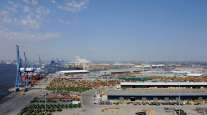Senior Reporter
COVID-19 Continues to Damage Business at Nation’s Ports on Both Coasts

[Ensure you have all the info you need in these unprecedented times. Subscribe now.]
The COVID-19 pandemic and Trump administration trade policies with China will result in at least a 15% drop in cargo this year at the Port of Los Angeles, the nation’s busiest seaport.
Gene Seroka, executive director at Port of Los Angeles, gave that forecast to reporters July 15 while discussing the impact of such events on one of California’s leading employment industries.
He said he expects the port to move 7,911,000 20-foot-equivalent unit (TEU) containers this year compared with 9,337,632 in 2019.

Seroka
Seroka said in June the port processed 691,475 containers, which is a 9.6% drop compared with 764,777 in the same month a year ago, which was a record for the month of June.
“Given the circumstances, we’re not in bad shape for the month of June,” Seroka said.
Nearby Port of Long Beach, the nation’s No. 2 port, logged an 11.1% drop in container volume in June, processing 602,180 TEUs compared with 677,167 in June last year.
“Canceled sailings continued to rise at a rapid rate in the second quarter as ocean carriers adjusted their voyages to a decline in demand for imports during the national COVID-19 outbreak,” said Mario Cordero, executive director at Port of Long Beach. “The economic challenges may persist for some time.”
The declines were reported a day after 52 organizations, led by the Pacific Merchant Shipping Association, sent a letter warning California Gov. Gavin Newsom that all West Coast ports face a continued “significant loss of market share” to East Coast facilities unless immediate steps are taken to make the ports more competitive.
The association also sent the governor and state lawmakers a report by economist and international trade adviser Jock O’Connell at Beacon Economics that showed West Coast ports’ market share has declined 19.4% since 2006.
“The loss of market share impacts labor unions, many of California’s leading employers, including retail, trucking, warehouse and distribution centers, ports, railroads, marine terminals, and export industries such as agriculture and aerospace,” the report said.
The Port of Oakland saw a 2.3% year-over-year decline in June, processing 199,011 containers compared with 203,730 the year before.
The drop prompted port commissioners to cut the budget by 15.8% to $432.5 million from $513.6 million.
“This budget is based on neither unsubstantiated hope nor on speculation of any worst-case scenario. It is based on best estimates of how our business may recover, assuming that our communities and country make slow but steady progress in containing the COVID-19 virus,” said Danny Wan, executive director at the Port of Oakland.
#Port of #Oakland Board votes labor leader Cluver as President; Leslie, Lee are Vice Presidents; Martinez returns for second term https://t.co/CtujL2WU3h #portcommissioners #portleadership #ports — Port of Oakland (@PortofOakland) July 16, 2020
Additionally, Alameda County labor leader Andreas Cluver was elected as president of the Port of Oakland’s seven-member Board of Port Commissioners on July 16. Cluver succeeds Ces Butner who had been Board President for the past two years.
The Northwest Seaport Alliance, which operates the combined ports at Seattle and Tacoma, Wash., moved 287,036 TEUs in June, a 16.4% decrease from 343,221 last year.
For the first half of the year, 1,564,263 TEUs were moved by the alliance, a decline of 18.3% from the same period last year when the ports processed 1,915,249 containers.
“This health crisis has generated unprecedented disruption to the global supply chain,” said John Wolfe, CEO of the alliance.
But the situation was not shaping up any better on the East Coast.
The Port of Virginia reported June container volumes fell 12% year-over-year, processing 210,669 TEUs compared with 239,329 the year before.
Through the first five months of 2020, overall container volumes declined 18.8% compared to 2019.
“Accurately measuring the results of a year turned upside-down by a pandemic is a significant challenge,” Virginia Port Authority CEO John Reinhart said. “Our average monthly TEU volume during the last half of the fiscal year was 212,000 units versus 242,000 units for the same period in fiscal 2019. During the height of the pandemic, there were 57 regularly scheduled vessel calls to Virginia that never happened because there wasn’t enough volume.”
Three other ports on the East Coast, New York/New Jersey — the nation’s third largest — Charleston and Savannah had not reported June container volume at press time.
Los Angeles’ Seroka sounded an alarm relevant to the drop in container volume at all of the ports: “Less cargo means fewer jobs at America’s ports. And we’re watching this very closely, where every job is important to our families, our children and our neighbors and the well-being of our harbor enclave.”
Want more news? Listen to today's daily briefing:
Subscribe: Apple Podcasts | Spotify | Amazon Alexa | Google Assistant | More




